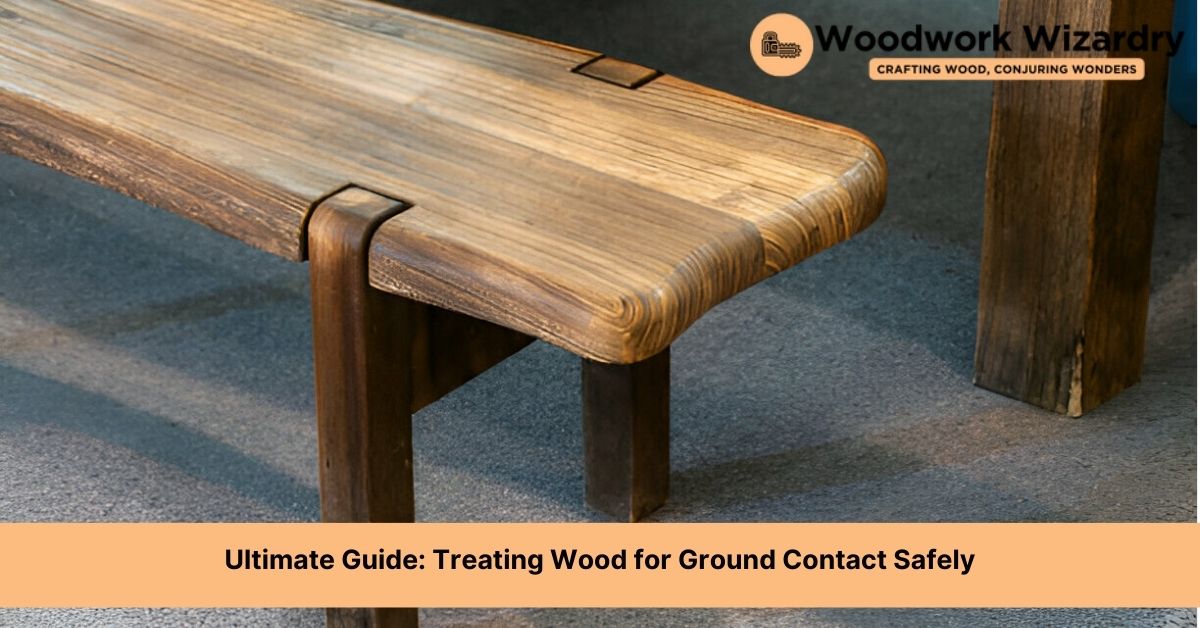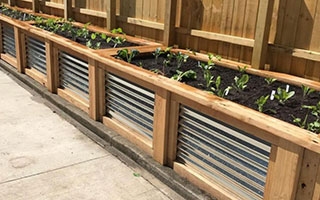To treat wood for ground contact, you can use a mixture of burnt motor oil and diesel fuel or a green dyed oil-based wood treatment/fungicide. Apply the treatment to the cut or exposed ends of the wood to prevent rotting.
It’s also recommended to place a barrier like gravel or concrete blocks between the wood and soil to reduce moisture and ensure good drainage. Charring the part of the wood that will be buried or in contact with the ground is another technique for wood preservation.
Farmers and old-timers often use this method for untreated lumber. These steps will help protect the wood and extend its lifespan when in contact with the ground.
Introduction To Ground Contact Wood Treatment
When it comes to treating wood for ground contact, it is important to protect it from rotting. One method is to place a barrier, such as gravel or concrete blocks, between the wood and the soil to reduce moisture. Good drainage around the structure is also crucial to keep the wood dry.
The Importance Of Proper Treatment
Proper treatment of wood for ground contact is essential to prevent decay and prolong the lifespan of wooden structures. Wood that comes into direct contact with the ground is particularly vulnerable to decay due to exposure to moisture, insects, and fungi. Without proper treatment, the wood can quickly deteriorate, compromising the structural integrity of the entire project.
Common Risks For Untreated Wood
Untreated wood in ground contact is at risk of rot, decay, and insect infestation. Moisture from the ground can lead to fungal growth, causing the wood to soften and lose its strength over time. Additionally, insects such as termites and carpenter ants are attracted to untreated wood, further accelerating its deterioration. Without proper treatment, wooden structures in ground contact are susceptible to premature failure and may require frequent replacement.
Choosing The Right Wood
When it comes to treating wood for ground contact, choosing the right type of wood is crucial for ensuring longevity and durability. Not all wood is suitable for ground contact, and using the wrong type can lead to premature decay and structural instability. In this section, we will explore the different types of wood suitable for ground contact and delve into the specifics of pressure-treated wood.
Types Of Wood Suitable For Ground Contact
When it comes to ground contact, certain types of wood excel in terms of resistance to decay and insect damage. Among the most suitable options are:
- Cedar
- Redwood
- Black Locust
- Pressure-treated Wood
Pressure-treated Wood Explained
Pressure-treated wood is a popular choice for ground contact applications due to its exceptional resistance to decay and insects. This type of wood is infused with preservatives under high pressure, ensuring deep penetration and long-lasting protection. The treatment process involves impregnating the wood with preservatives, such as chromium, copper, and arsenic, to fortify it against environmental stressors.
Pre-treatment Preparations
Before treating wood for ground contact, it is important to properly prepare the wood to ensure the treatment is effective and long-lasting. This involves cleaning and sanding the wood and assessing its condition. Let’s dive into each of these steps in detail:
Cleaning And Sanding The Wood
Prior to treating the wood, it is crucial to clean off any dirt, debris, or previous coatings. This can be done by using a brush or broom to remove loose particles and then washing the wood with a mild detergent and water. Rinse the wood thoroughly and allow it to dry completely before proceeding.
Once the wood is clean and dry, sanding the surface is important to remove any roughness or splinters. This can be done using sandpaper or a power sander, depending on the size of the project. Sand the wood in the direction of the grain until the surface feels smooth to the touch.
Assessing Wood Condition
After cleaning and sanding, it is essential to assess the condition of the wood. Check for signs of rot, decay, or insect damage. Inspect the wood for cracks, splits, or any other structural issues that may affect its durability.
If the wood is severely damaged or compromised, it may be necessary to replace the affected areas or consider using a different type of wood that is more resistant to decay.
It is also important to ensure that the wood is properly seasoned and has a moisture content of less than 20%. Wood with high moisture content is more susceptible to rot and decay, so it is crucial to allow the wood to dry adequately before treatment.
By thoroughly cleaning and sanding the wood and assessing its condition, you can ensure that the treatment will penetrate effectively and provide long-lasting protection against ground contact elements.

Credit: woodworkwizardry.com
Charring Method For Preservation
To treat wood for ground contact, one effective method is the charring technique. This involves lightly burning the part of the wood that will be buried or in contact with the ground. It is important to use untreated lumber for this method to ensure safety.
Step-by-step Charring Process
The charring method is a popular technique for preserving wood that will be in contact with the ground. This process involves burning the surface of the wood to create a protective barrier against moisture, rot, and insects. Here is a step-by-step guide on how to char wood for ground contact:
- Select untreated lumber: Make sure to choose untreated wood for charring, as the process can be unsafe with treated wood.
- Gather safety equipment: Before starting the charring process, ensure you have safety goggles, gloves, and a fire extinguisher nearby.
- Prepare the wood: Remove any dirt or debris from the wood surface using a brush or sandpaper.
- Create a controlled fire: Set up a controlled fire using a torch or a campfire. Make sure the fire is contained and safe.
- Hold the wood over the fire: Hold the wood piece about three feet above the fire, allowing the flames to char the surface. Move the wood around to ensure even charring.
- Monitor the charring process: Keep a close eye on the wood as it chars. You want to achieve a dark, charred surface without burning the wood too deeply.
- Remove the wood from the fire: Once the desired charring level is achieved, carefully remove the wood from the fire using tongs or gloves. Be cautious as the wood will be hot.
- Allow the wood to cool: Place the charred wood on a non-flammable surface and let it cool completely before handling.
Safety Precautions During Charring
It is essential to prioritize safety when using the charring method for wood preservation. Here are some safety precautions to follow:
- Wear protective gear: Always wear safety goggles and gloves to protect your eyes and hands from sparks and heat.
- Work in a well-ventilated area: Make sure you char the wood in an open space or a well-ventilated area to avoid inhaling harmful fumes.
- Keep a fire extinguisher nearby: Have a fire extinguisher or a water source readily available in case of any emergencies.
- Monitor the fire: Never leave the fire unattended and keep a close eye on it to prevent accidents.
- Dispose of ashes safely: After the charring process, dispose of the ashes in a designated area away from flammable materials.
By following these step-by-step instructions and safety precautions, you can effectively use the charring method to treat wood for ground contact. This preservation technique helps prolong the lifespan of the wood and ensures its durability in outdoor applications.
Chemical Treatments And Preservatives
To treat wood for ground contact, it is important to use chemical treatments and preservatives to protect the wood from rot, decay, and insect damage. One option is to use Barrettine wood preserver, which protects against wood-destroying fungi, wood discolouring fungi, and wood-boring insects.
Another option is to char the part of the wood that will be in contact with the ground, which can help prevent rotting. Proper wood treatment is crucial for the longevity and durability of any outdoor wooden structure.
Chemical Treatments and Preservatives are an essential part of treating wood for ground contact. Chemicals are used to protect the wood from rot, decay, and insect damage, which can significantly extend the life of the wood. However, not all preservatives are created equal, and selecting the right one is critical for ensuring the longevity of the wood. In this post, we will discuss the best practices for selecting the right preservative and application techniques for chemical treatments.Selecting The Right Preservative
When selecting a preservative, it is important to consider the type of wood you are treating, the environment it will be exposed to, and the level of protection you require. Some common preservatives include Copper Azole, Alkaline Copper Quaternary, and Micronized Copper Azole. The choice of preservative will depend on the intended use of the wood and the level of protection required.Application Techniques For Chemical Treatments
Once you have selected the right preservative, it is time to apply it to the wood. The most common application methods include brushing, spraying, or dipping the wood into the preservative solution. However, the best method will depend on the type of preservative being used and the size and shape of the wood. It is essential to ensure that the wood is dry before applying the preservative, as moisture can interfere with the effectiveness of the treatment. Additionally, it is crucial to wear protective gloves and clothing when working with preservatives, as they can be harmful to skin and respiratory systems. In conclusion, chemical treatments and preservatives are an effective way to protect wood from rot, decay, and insect damage. By selecting the right preservative and using the correct application techniques, you can significantly extend the life of the wood.Natural And Eco-friendly Alternatives
Protecting wood for ground contact can be achieved using natural and eco-friendly alternatives. Utilizing charred wood or wood preservatives can effectively prevent rot and decay, ensuring the longevity of wooden structures in contact with the ground. Additionally, employing barriers like gravel or concrete blocks can reduce moisture and enhance wood preservation.
Natural and Eco-Friendly Alternatives When it comes to treating wood for ground contact, many people turn to chemical preservatives. However, if you are looking for a more natural and eco-friendly option, there are alternatives available. In this section, we will explore some of these alternatives, including using oil and diesel mixtures and eco-friendly commercial preservatives. Using Oil and Diesel Mixtures One natural way to protect wood from ground contact is by using a mixture of oil and diesel. This mixture is applied to the wood and helps to repel water, preventing rot and decay. While this method is effective, it should only be used on untreated wood and should be applied in a well-ventilated area. To use this method, you will need: – 1 gallon of used motor oil – 1 gallon of diesel fuel Mix the oil and diesel together and apply the mixture to the wood using a brush or spray bottle. Be sure to wear protective gear, such as gloves and a mask, as the fumes from the mixture can be harmful. Eco-Friendly Commercial Preservatives If you prefer to use a commercial wood preservative, there are eco-friendly options available. These preservatives are made from natural ingredients and are biodegradable, making them a more sustainable choice. One example of an eco-friendly wood preservative is Barrettine Wood Preserver. This preservative is designed to protect wood from wood-destroying fungi, wood discolouring fungi, and wood-boring insects. It is also water-based, making it safe for use around plants and animals. When using any wood preservative, be sure to follow the manufacturer’s instructions carefully and wear protective gear as needed. With these natural and eco-friendly alternatives, you can protect your wood from ground contact while also minimizing your impact on the environment.Physical Barriers And Design Considerations
To treat wood for ground contact, consider using pressure-treated wood or applying a wood preservative to protect it from moisture and decay. Additionally, charring the part of the wood that will be in contact with the ground can provide further protection against rot.
Properly treated wood can ensure durability and longevity in outdoor structures.
Installing Gravel Or Concrete Barriers
When it comes to treating wood for ground contact, physical barriers play a crucial role in preventing moisture and decay. One effective method is installing gravel or concrete barriers. These barriers act as a protective layer between the wood and the soil, reducing the amount of moisture that comes into contact with the wood. Gravel barriers are a cost-effective option that provide good drainage and minimize direct wood-soil contact. By creating a layer of gravel around the wood structure, you create a barrier that allows water to drain away, preventing moisture buildup. This helps to extend the lifespan of the wood and reduce the risk of rot and decay. Concrete barriers offer even stronger protection against ground contact. They can be used as footings or piers to elevate the wood structure above the ground level. By elevating the wood, you create a physical barrier that prevents direct contact with the soil. Concrete barriers are highly durable and provide excellent structural support for wood structures such as decks, fences, and posts.Elevating Wood Structures
Another effective design consideration for treating wood for ground contact is to elevate the wood structures. By raising the wood above the ground level, you can minimize the amount of moisture that comes into contact with the wood, reducing the risk of decay and rot. One way to elevate wood structures is by using pressure-treated lumber or composite materials that are specifically designed for ground contact. These materials have been treated with preservatives that protect against decay and insect infestation. They are highly resistant to moisture and provide long-lasting durability. Alternatively, you can use concrete or stone piers to elevate the wood structure. This method involves placing the wood on top of the piers, creating a gap between the wood and the ground. This gap allows for air circulation and drainage, preventing moisture buildup and prolonging the lifespan of the wood. In conclusion, physical barriers and design considerations are crucial when treating wood for ground contact. Installing gravel or concrete barriers and elevating wood structures are effective methods to protect against moisture and decay. By implementing these measures, you can ensure the longevity and durability of your wood structures in outdoor environments.
Credit: www.prowoodlumber.com
Sealing And Coating Options
When it comes to treating wood for ground contact, sealing and coating options play a crucial role in protecting the wood from moisture, decay, and insect damage. Choosing the right sealant or coating can significantly extend the lifespan of your wood and ensure its durability in outdoor settings.
Advantages Of Wood Sealants
Wood sealants offer numerous advantages when it comes to protecting wood in ground contact. They create a barrier on the surface of the wood, preventing water and moisture from penetrating the material. This barrier also helps to reduce the risk of fungal decay and insect infestation, which can ultimately lead to the deterioration of the wood. Additionally, wood sealants enhance the natural beauty of the wood by providing a clear or tinted finish, making it an aesthetically pleasing choice for outdoor projects.
Applying Stain And Sealant
Applying stain and sealant to wood for ground contact requires careful attention to ensure proper protection. Here is a step-by-step guide on how to apply stain and sealant effectively:
- Clean the wood surface: Before applying any stain or sealant, make sure the wood surface is clean and free from dirt, debris, and previous coatings. Use a mild detergent or wood cleaner to remove any stains or residues.
- Prepare the wood: Sand the wood surface to smooth out any rough spots or imperfections. This step also helps the stain and sealant adhere better to the wood.
- Apply stain: Use a brush, roller, or sprayer to apply the stain evenly on the wood surface. Work in small sections and follow the manufacturer’s instructions regarding drying time and number of coats needed.
- Apply sealant: Once the stain has dried, apply a layer of sealant to protect the wood from moisture and UV damage. Choose a sealant that is specifically designed for ground contact and apply it following the manufacturer’s instructions.
- Allow drying time: Give the stain and sealant enough time to dry thoroughly before subjecting the wood to ground contact. This will ensure maximum protection and longevity.
Remember, proper maintenance is essential to prolong the lifespan of the treated wood. Regularly inspect the wood for any signs of wear or damage and reapply stain and sealant as necessary.
Maintenance And Longevity
Ensuring the longevity of wood in ground contact requires regular maintenance and treatment. By implementing routine checks and proper maintenance tips, you can significantly extend the lifespan of the wood and prevent decay.
Routine Checks And Maintenance Tips
Regularly inspect the wood for signs of decay, moisture retention, or pest infestation. Keep the wood clean and free of debris to prevent moisture buildup. Apply a fresh coat of preservative or sealant as needed to maintain protection against environmental factors.
When To Reapply Treatments
It is recommended to reapply treatments every 1-3 years, depending on the type of preservative used and the environmental conditions. Factors such as exposure to moisture, sunlight, and temperature fluctuations can impact the longevity of the treatment, necessitating timely reapplication to ensure continued protection.

Credit: mtcopeland.com
Cost Analysis And Budgeting
When treating wood for ground contact, it’s essential to consider the cost implications and create a budget that aligns with your project requirements. Here’s a breakdown of the key cost factors to consider:
Estimating Treatment Costs
Before embarking on wood treatment for ground contact, it’s crucial to estimate the associated costs. This includes the cost of the treatment chemicals, protective gear, and any additional equipment required for the application process. Moreover, consider the long-term maintenance costs to ensure the treated wood remains durable over time.
Diy Vs. Professional Treatment Services
One important decision to make when budgeting for wood treatment is whether to opt for a do-it-yourself approach or seek professional treatment services. Here’s a comparison of the cost implications for each option:
- DIY Treatment: While DIY treatment may seem cost-effective initially, it’s essential to factor in the cost of purchasing quality treatment chemicals, protective gear, and any equipment needed. Additionally, consider the time and effort required for the application process.
- Professional Treatment Services: Opting for professional treatment services may involve higher upfront costs, but it offers the expertise of trained professionals and access to specialized treatment methods. Consider obtaining quotes from different service providers to compare costs and services offered.
Common Mistakes To Avoid
When treating wood for ground contact, it’s crucial to avoid common mistakes that can compromise the effectiveness of the treatment. By steering clear of these errors, you can ensure the longevity and durability of your wooden structures.
Improper Application Errors
One of the most common mistakes in treating wood for ground contact is improper application. This includes not following the manufacturer’s guidelines for application methods and failing to apply the treatment evenly across all surfaces of the wood. Uneven application can leave vulnerable spots that are susceptible to decay, undermining the overall protection of the wood.
Neglecting Environmental Factors
Neglecting environmental factors is another critical mistake to avoid. Failure to consider the specific environmental conditions in which the wood will be placed can lead to inadequate protection. Factors such as moisture levels, temperature fluctuations, and exposure to sunlight can all impact the effectiveness of the treatment over time.
Conclusion: Ensuring Durable Wood In Ground Contact
To ensure durable wood in ground contact, it’s crucial to apply a suitable wood preservative to protect against decay and insect damage. Properly treated wood can withstand the harsh conditions of being in direct contact with the ground, prolonging its lifespan and maintaining structural integrity.
Applying an effective wood preservative is essential for preventing rot and ensuring longevity.
Summary Of Best Practices
When it comes to wood in ground contact, there are several best practices that can help ensure its durability. These include using pressure-treated wood, applying a wood preservative, and providing proper drainage. Additionally, using gravel or concrete blocks as a barrier between the wood and soil can help reduce moisture and prevent rot.Final Thoughts On Wood Treatment
Treating wood for ground contact is essential for ensuring its longevity and durability. While there are several methods for treating wood, it’s important to choose the method that best suits your needs and budget. Whether you choose to pressure-treat the wood or apply a wood preservative, be sure to follow the manufacturer’s instructions carefully. With proper treatment, your wood can withstand years of exposure to the elements and remain structurally sound for years to come.Frequently Asked Questions
How To Protect Wood That Touches The Ground?
To protect wood that touches the ground, you can follow these steps: 1. Place a barrier like gravel or concrete blocks between the wood and the soil to reduce moisture. 2. Ensure good drainage around the structure to keep the wood dry.
3. Use wood preservatives like Barrettine Wood Preserver to protect against fungi and wood-boring insects. 4. Consider using the “charring” method for untreated lumber, where you lightly burn the wood that will be buried or in contact with the ground.
5. Regularly inspect and maintain the wood to ensure its long-term protection. By following these guidelines, you can effectively protect wood that touches the ground and prolong its lifespan.
How Do You Keep Wood From Rotting In The Ground?
To prevent wood from rotting in the ground, you can follow these steps: 1. Place a barrier, like gravel or concrete blocks, between the wood and soil to reduce moisture. 2. Ensure good drainage around the structure to keep the wood dry.
3. Use a wood preservative, such as Barrettine wood preserver, to protect against wood-destroying fungi and insects. 4. Consider charring the part of the wood that will be buried or in contact with the ground, using a torch or campfire.
5. Treat the cut ends of the wood with a green dyed oil-based wood treatment/fungicide. By taking these precautions, you can help prolong the life of wood in ground contact.
What Preservative To Use On Wood In Contact With Ground?
Barrettine wood preserver is a reliable choice to protect wood in contact with the ground. You can also use a combination of burnt motor oil and diesel fuel, or Armor All Wood Preservative Pre-Stain. Ensure good drainage and place a barrier like gravel or concrete blocks between the wood and soil to reduce moisture.
How To Treat Wood Post Before Putting In Ground?
To treat wood posts before putting them in the ground, you can use the charring method, which involves lightly burning the part of the wood that will be buried. This technique is only safe for untreated lumber. You can also use wood preservatives like Barrettine Wood Preserver.
It’s important to place a barrier between the wood and soil, like gravel or concrete blocks, to reduce moisture and ensure good drainage around the structure to keep the wood dry.
How Can I Protect Wood From Rotting In The Ground?
To protect wood from rotting in the ground, place a barrier like gravel or concrete blocks between the wood and the soil to reduce moisture. Ensure good drainage around the structure to keep the wood dry.
Conclusion
Treating wood for ground contact is crucial for its longevity and durability. Whether you choose to pressure treat, char, or apply a preservative, it’s important to take necessary precautions to prevent rot and decay. It’s also essential to maintain good drainage and avoid direct soil contact.
With the right treatment and care, your wooden structures can withstand the test of time and weather.





